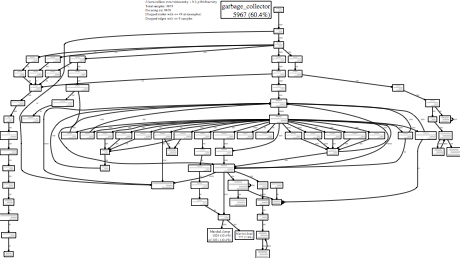Fast Compact Sparse Bit Sets
Imagine you need a relatively compact data structure for quickly checking membership of mostly-consecutive non-negative integers. (If this sounds really specific, it is because it is precisely what I needed for a particular project.)
The Ruby standard library contains a Set class which may be a good starting point. Set is actually implemented as a Hash with the Set elements as keys and true as the values. Thus the overhead for storing a value in the Set is essentially only the value itself since all keys point to the same true object. Assuming a 64-bit machine, the overhead will be 64 bits per value. This seems reasonable, but given the specific limitations of the values we wish to store, perhaps we can do better?
Bit Sets
A bit set is a compact data structure of binary values where membership is indicated by setting a bit to 1. The position of the bit indicates the element value. For example, the second bit from the right might be used to indicate whether or not the value 1 is in the set.
One method to determine membership is to AND the bit set with a mask with only the desired bit set to 1. If the result is 0, the value is not in the set. If it is any other result (actually the mask itself, but the zero check is sufficinet), the value is a member of the set.
In Ruby, this looks like
bitset & (1 << num) != 0
For example, to check if the value 4 is in the set, we use the mask 00010000 (the 5th bit from the right is set to 1) which is the decimal value 8:
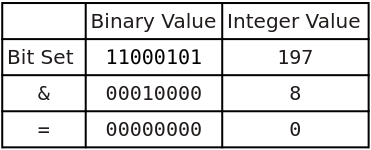
Since the result is zero, we know the value 4 is not in the set.
If we check for the value 6, the result is not zero, indicating the value is a member of the set:
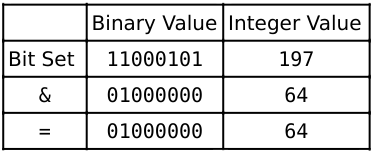
Now, instead of 64 bits per value, it only requires a single bit! Now we just need to put a lot of bits together, either by using a long string or a bunch of integers in an array.
Sparse Bit Sets
The problem with a long binary string or an array of integers is that membership is entirely position-based. To store the value 1000, the data structure requires 1001 bits, all but one of which is set to 0. This is quite inefficient, especially for very large values.
One solution is to create a sparse bit set by combining a hash table with bit sets as values. The hash table keys provide fast look up of the correct bit set, then the bit set is checked for the desired element. The keys indicate the lowest value stored in the bit set (e.g., the decimal key 4 pointing to the binary bit set 00000001 would mean the value 4 is in the set).
Below is an example of a hash table using integer keys and 8 bit integers for the bit sets:
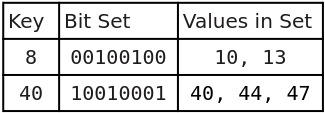
The average overhead is ⌊(m * n) / w⌋ + m bits, where m is the number of values (assumed to be consecutive), w is the number of bits per bit set, and n is the number of bits per key. In 64-bit Ruby, if we use integers for the bit sets, n = 64 and w = 62*. This works out to an average of 2 bits per value in the set. Of course, a single value incurs the overhead of both the key and the bit set: 128 bits! But if there are many consecutive values, the cost per value begins to shrink. For example, the numbers 0 to 61 can be stored in a single bit set, so 62 values can be stored in the 128 bits and we are back to about 2 bits per value.
Note that while it is best to use consecutive values which fit neatly into the bit sets (in this case, runs of 62 integers), the sequences can start and end at arbitrary points with only a little “wasted” overhead. To store just the number 1000, we now only need 128 bits, not 1001.
On top of the space savings, the membership checks remain fast. Still assuming 64-bit Ruby, to determine if a value is in the table look up index i = value / 61. Then check the bit set with bitset & (1 << (value % 61) != 0 as previously. (The divisor is 61 because there are 62 bits, but the values are 0 to 61).
Space Efficiency
I have implemented a Ruby version of the data structure described above which I call the Dumb Numb Set (DNS).
To measure the space used by the bit sets, we compare the Marshal data size for the bit sets versus regular Hashes (using true for all values, just like a Ruby Set).
These are the results for perfectly ordered data on a 64-bit version of Ruby 1.9.3 (size is number of bytes):
Items Hash DNS %reduction
---------------------------------------------
1 | 7 | 41 |-486%
100 | 307 | 61 | 80%
1k | 4632 | 253 | 95%
10k | 49632 | 2211 | 96%
100k | 534098 | 24254 | 95%
1M | 5934098 | 245565 | 96%
10M | 59934098 | 2557080 | 96%
100M | 683156884 | 26163639 | 96%
1B | ? | 262229211 | ?
---------------------------------------------
At 1 billion items, my machine ran out of memory.
For a single item, as expected, overhead in the DNS is quite high. But for as little as 100 items in the set, the DNS is considerably more compact.
This is, however, the best case scenario for the DNS. Less perfectly dense values cause it to be less efficient. For very sparse values, a Hash/Set is probably a better choice.
Even Better Space Efficiency
It may not surprise you to find out I was very interested in minimizing the serialized version of the sparse bit set for sending it over a network. In investigating easy but compact ways of doing so, I realized the Marshal data for Hashes and integers is not very compact, especially for large integers.
Fortunately, there is an existing solution for this scenario called MessagePack. For storing 1 million values, serialized size is reduced from 245,565 to 196,378 bytes (20%). The DNS will use MessagePack automatically if it is installed.
Performance
Somewhat surprisingly, the DNS is quite fast even when compared to MRI Ruby’s Hash implementation.
With MRI Ruby 1.9.3p448 (x86_64) and 1 million values:
user system total real
Hash add random 0.540000 0.020000 0.560000 ( 0.549499)
DumbNumbSet add random 0.850000 0.020000 0.870000 ( 0.864700)
Hash add in order 0.540000 0.020000 0.560000 ( 0.556441)
DumbNumbSet add in order 0.490000 0.000000 0.490000 ( 0.483713)
Hash add shuffled 0.570000 0.020000 0.590000 ( 0.589316)
DumbNumbSet add shuffled 0.540000 0.010000 0.550000 ( 0.538420)
Hash look up 0.930000 0.010000 0.940000 ( 0.940849)
DNS look up 0.820000 0.000000 0.820000 ( 0.818728)
Hash remove 0.980000 0.030000 1.010000 ( 0.999362)
DNS remove 0.950000 0.000000 0.950000 ( 0.953170)
The only operation slower than a regular Hash is inserting many random values. All other operations are roughly equal.
Conclusion
For my specific scenario, a simple custom data structure was just as fast as a built-in data structure, but required significantly less space for the expected use case.
There are other solutions for this type of problem, but it should be noted I only really care about fast insertion, fast membership checks, and compact representation. Additionally, values may be very large, although I attempt to keep them within the Fixnum range for Ruby (i.e. less than 262 - 1). This rules out some implementations which require arrays the size of the maximum value!
I also did not want to deal with compression schemes, of which there are quite a few, since my sets were going to be dynamic. I imagine there are very efficient implementations for fixed data sets.
Footnote: Integer Size in Ruby
Integers in 32-bit MRI Ruby only have 30 bits available, and in 64-bit MRI Ruby they only have 62 bits available:
$ irb
1.9.3p448 :001 > ("1" * 62).to_i(2).class
=> Fixnum
1.9.3p448 :002 > ("1" * 63).to_i(2).class
=> Bignum
Avoiding SQL Injection in Rails
SQL injection (SQLi) is any situation in which a user can manipulate a database query in an unintended manner. Consequences of SQL injection vulnerabilites range from data leaks, to authentication bypass, to root access on a database server. In short, it is a very big deal.
Most Rails applications interact with a database through ActiveRecord, the default and convenient Object Relational Mapping (ORM) layer which comes with Rails. Generally, use of ORMs is safer than not. They can provide abstraction and safety and allow developers to avoid manually building SQL queries. They can embody best practices and prevent careless handling of external input.
Instead of unsafe code like
query = "SELECT * FROM users WHERE name = '#{name}' AND password = '#{password'} LIMIT 1"
results = DB.execute(query)
You can have safer, simpler code like
User.where(:name => name, :password => :password).first
My impression is many people assume the Rails framework will protect them as long as they avoid the “obviously dangerous” methods, like find_by_sql.
Unfortunately, ActiveRecord is unsafe more often than it is safe. It does provide parameterization of queries (the API documentation for which can be found here) for some methods, there are many methods for which it does not. While these methods are not intended to be used with user input, the truth is that has never stopped anyone.
To make it clear how dangerous it can be to use ActiveRecord, consider ActiveRecord::FinderMethods#exists? which queries the database and returns true if a matching record exists. The argument can be a primary key (either integer or string, if a string it will be sanitized), an array consisting of a template string and values to safely interpolate, or a hash of column-value pairs (which will be sanitized).
Here is an example of using exists? to determine if a given user exists:
User.exists? params[:user_id]
This looks harmless, since params[:user_id] is a string, and strings will be sanitized. In fact, the documentation clearly points out not to pass in conditions as strings, because they will be escaped.
However, there is no gaurantee params[:user_id] is a string. An attacker could send a request with ?user_id[]=some_attack_string, which Rails will turn into an array ["some_attack_string"]. Now the argument is an array, the first element of which is not escaped.
To avoid this problem, the user input should be converted to the expected type:
User.exists? params[:user_id].to_i
Or use a hash:
User.exists? :id => params[:user_id]
This should be the approach for all uses of user input. Do not assume anything about values from external sources or what safety mechanisms a method might have.
While working on Brakeman, I thought it would be useful to put together a list of all the unsafe ways one can use ActiveRecord.
To make it easier on myself, I built the list into a Rails application so I could easily test, verify, and record any findings. The source is available here for those who would like try out the examples. The application is a single page of all the queries and example injections. From there one can submit queries and see the results:
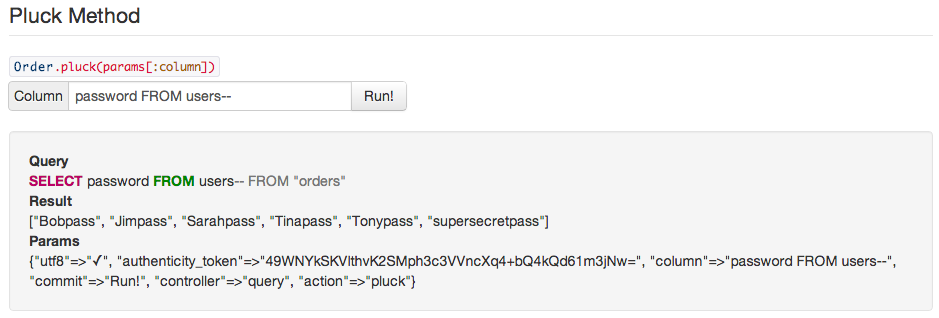
The resulting information is available at rails-sqli.org, including examples of how SQL injection can occur and the resulting queries. This is basically a big list of what not to do when using ActiveRecord. Again, please feel free to contribute so that the list can be as authoritative as possible and help everyone avoid SQL injection in Rails.
Faster Call Indexing in Brakeman
Background
About a month ago, an issue was reported where Brakeman taking a ridiculously long time on the “call indexing” step. At the time, I was pessimistic about opportunities to improve the performance of call indexing, since it is a pretty simple operation.
Call Indexing
The majority of the checks performed by Brakeman involve finding and examining method calls (e.g., SQL queries). In order to make these checks faster, Brakeman scans an app once and then saves information about each method call in a data structure called the “call index”. This makes searching for specific method calls very fast.
The call index allows search for methods by name and also by the class of the target. For example, it is possible to search for all calls to open on File. It also allows searching via regular expressions for methods and targets.
Investigation
I happened to notice a Rails application in my collection which also seemed to take a long time indexing calls. So I ran it through perftools.rb to see if there was anything interesting going on.
This is the result:
The large amount of time spent in the garbage collector (60%) was high even for Brakeman. But then something else caught my eye:
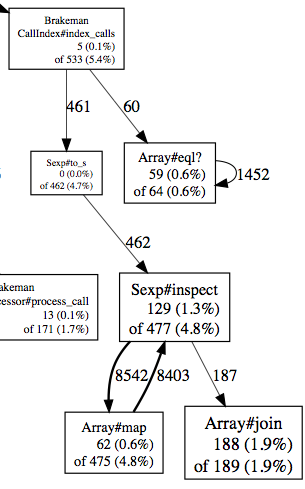
This scan spent 4.7% of its time converting Sexps to strings while indexing calls. This seemed excessive.
This is the entirety of the call indexing code:
```ruby call_index.rb def index_calls calls calls.each do |call| @methods « call[:method].to_s @targets « call[:target].to_s @calls_by_method[call[:method]] « call @calls_by_target[call[:target]] « call end end
`@methods` and `@targets` are sets which contain the string versions of all the methods and method targets. This is *exclusively* used to search for methods and targets via regular expressions.
The call method will always be a symbol...but what about the target? It turns out that while much of the time it is a symbol, if a sane value like `:File` or `:@something` cannot be found, then it will be the entire `Sexp`! This is where Brakeman was wasting time calling `Sexp#to_s`.
The quick fix was to only store symbol targets in the `@targets` set, ignoring any other target values.
## Results
Scanning the same application with Brakeman 1.8.3 has this result:
[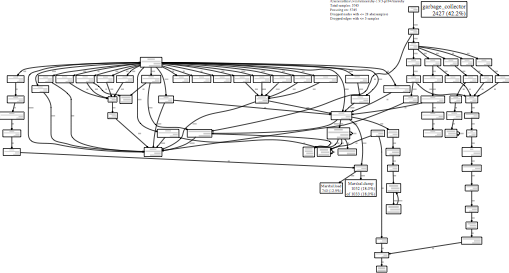](/images/blog/brakeman-scan-1.8.3.pdf)
Garbage collection time dropped from 60% to 42%. While still very high, this is a good sign. Time spent indexing calls has dropped from 5.4% to 1.8% and the calls to `Sexp#to_s` have vanished.
The total scan time dropped from 3.5 minutes to about 2 minutes. For the original reporter, scan times went from [78 minutes to 40 *seconds*](https://github.com/presidentbeef/brakeman/issues/171#issuecomment-10344355).
## More Improvements
Looking through Brakeman, it does not currently use the "search via regex" feature for the call index. So the method and target name sets can be removed entirely.
Going even further, nowhere does Brakeman search for targets by any values other than symbols. Note in the graph below that `Array#eql?` was sampled 1,330 times during call indexing:
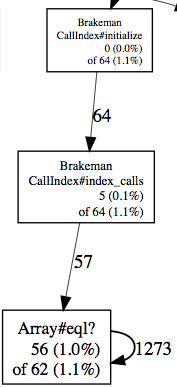
Since `Sexp`s are subclassed from `Array`, it is clear that these calls are generated when using the `call[:target]` as a hash key (line 6 above). Again, the current Brakeman code only searches for call targets by symbol, never by a full `Sexp`. There is no reason to the call targets that are `Sexp`s.
This is the modified call indexing code:
```ruby Modified call_index.rb
def index_calls calls
calls.each do |call|
@calls_by_method[call[:method]] << call
unless call[:target].is_a? Sexp
@calls_by_target[call[:target]] << call
end
end
end
With this code in place, call indexing does not even show up under perftools. Speed improvements vary by project, but this should at least shave off a few seconds. YMMV.
Wrapping Up
Some quick profiling led me to performance improvements where I really did not expect to find them. Sadly, this is one of the cleanest, simplest parts of Brakeman, so I know there are many other instances where Brakeman can be improved. Prior to the introduction of the call index in Brakeman 1.0, I was trying to keep Brakeman scans under 20 minutes (on large applications). Now I worry when scans take longer than a few minutes.
97% of the open source Rails applications I use as test cases can be scanned in less than 30 seconds. Unfortunately, this probably does not reflect scan times for large, commercial applications. Please report any long-running scans! It may lead to more speed improvements like the ones above.
